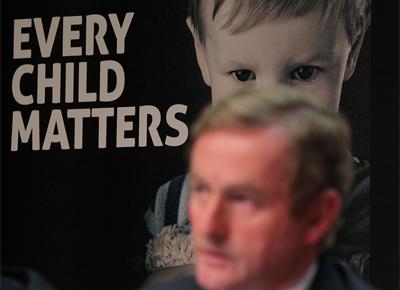We could hardly care less about most of our children

This referendum campaign is part of the concerted denial of how we could hardly care less about very many of our children. By Vincent Browne.
The arresting black and white poster, with the photograph of a charming child, accompanied by the slogan “Every Child Matters”, is one of the falsehoods perpetrated by the Government parties urging support for the children’s rights referendum.
In this State and in this society every child does not matter. We could hardly care less about most of the nation’s children and as for protecting them from rape, buggery, abuse and trauma, we make gestures and do little else.
This referendum campaign is part of the concerted denial of how we could hardly care less about very many of our children and once it is passed, there will be reason not to care at all, in the illusion that we have done our bit by voting “Yes”.
Let’s start with the rape, buggery, abuse and trauma that children suffer that we do so little about.
A report published 10 years ago, funded by two government departments, Justice and Health, revealed a scale of rape, buggery and abuse of children that was truly shocking. But almost no attention was paid to it by governments, State agencies, and, incidentally, the media. This was the SAVI Report: Sexual Abuse and Violence in Ireland: A National Study of Irish Experiences, Beliefs and Attitudes Concerning Sexual Violence. It was conducted by a survey team in the Royal College of Surgeons: Hannah McGee, Rebecca Garavan, Mairéad de Barra, Joanne Byrne and Ronan Conroy.
It revealed the following:
* One in five women (24%) reported experiencing contact sexual abuse in childhood and about one-third of these (7.6% of all women) experienced attempted or actual penetrative sex in childhood (ie rape or attempted rape). That is almost a quarter of all women in Ireland were sexually abused in childhood and one in 13 women was subjected to rape or attempted rape in childhood;
* One in six men (16.2%) reported experiencing contact sexual abuse in childhood and about a quarter of these (4.2%) experienced attempted or actual penetrative sex in childhood;
* Overall, almost one-third of women and a quarter of men reported some level of sexual abuse in childhood (that is contact and non-contact sexual abuse – non-contact sexual abuse includes being exposed to pornography or actual sexual scenes);
* Most sexual abuse in childhood and adolescence occurred in the pre-pubescent period, with two-thirds (67%) of abused girls and 62% of abused boys having experienced abuse by 12 years of age;
* A third (36%) of those who had experienced sexual abuse as a child now believe that their abuser was also abusing other children at the time;
* A quarter (24%) of perpetrators against girls were family members, half (52%) were non-family but known to the abused girl, and a quarter (24%) were strangers;
* One in seven perpetrators (14%) against boys was a family member, with two-thirds (66%) non-family but known to the abused boy. One in five (20%) were strangers.
We are talking here about an epidemic of sexual abuse of people in their childhood, nearly 12% of the population, maybe hundreds of thousands of abusers.
What would you think a government or a political establishment, generally, or a society would do when faced with such startling disclosures about the rape and abuse of children? Yes, some people might be disbelieving, thinking there was some defect in the research. But wouldn’t you think the disbelievers or sceptics in government would want to assure themselves that the scale of abuse was not of these proportions by funding further studies? That did not happen.
The Dublin Rape Crisis Centre, which had instigated the SAVI report, sought funding from government on several occasions over the last several years to have another survey conducted on the scale of the abuse. But no funding was forthcoming – it wasn’t a priority!
No credible challenge has been made to the methodology of the survey or the integrity of the researchers/authors, so there is no reason to believe that it does not convey the reality.
Nevertheless, there was no response to these findings, in terms of policy changes or action, in any way proportionate to the scale of the problem revealed. Fundamentally, nothing was done to protect the nation’s children from abuse. Children did not matter. And nobody on the opposition benches protested, none of the bishops said a word (as far as I recall), and few of the practised handwringers did anything.
Now we have a proposed constitutional amendment that, supposedly, will protect children, an amendment that in part changes nothing (the assertion about children’s rights, as though that was not already implicit in the Constitution), does change the law on the adoption of children of married parents and this is of course welcome. But then the proposed amendment bows to the fundamentalists in according rights to the family, an institution that has been the locus of the widespread abuse of children.
Aside from that, if children really do matter, how come so many are in poverty, or fail to get adequate education? How come so many children are denied adequate healthcare? Once this amendment is passed children can be placed on the back burner.
Some might say literally.
